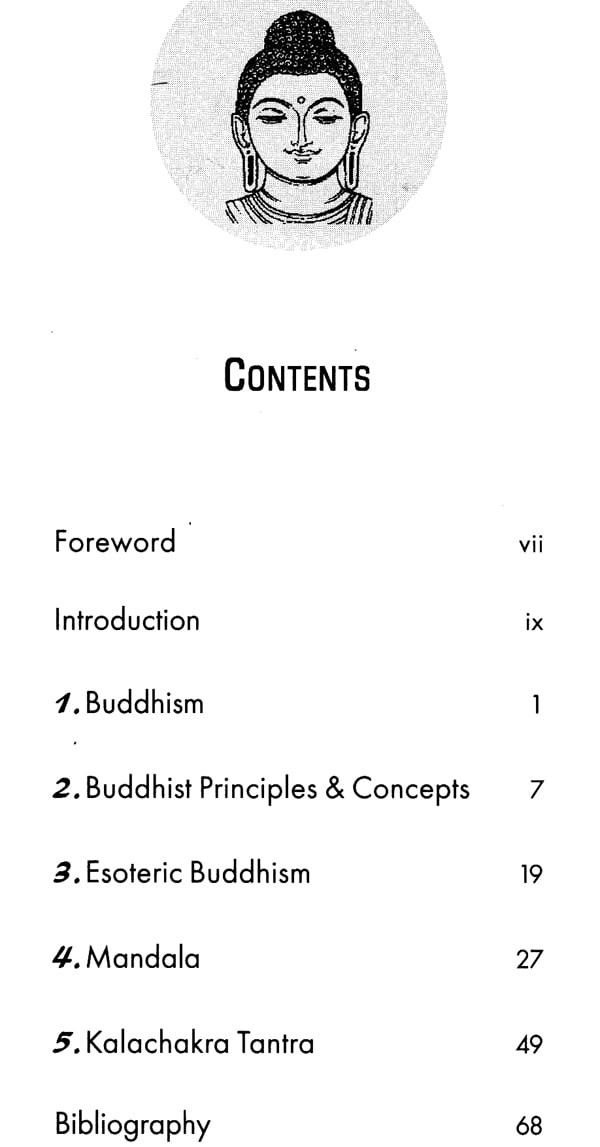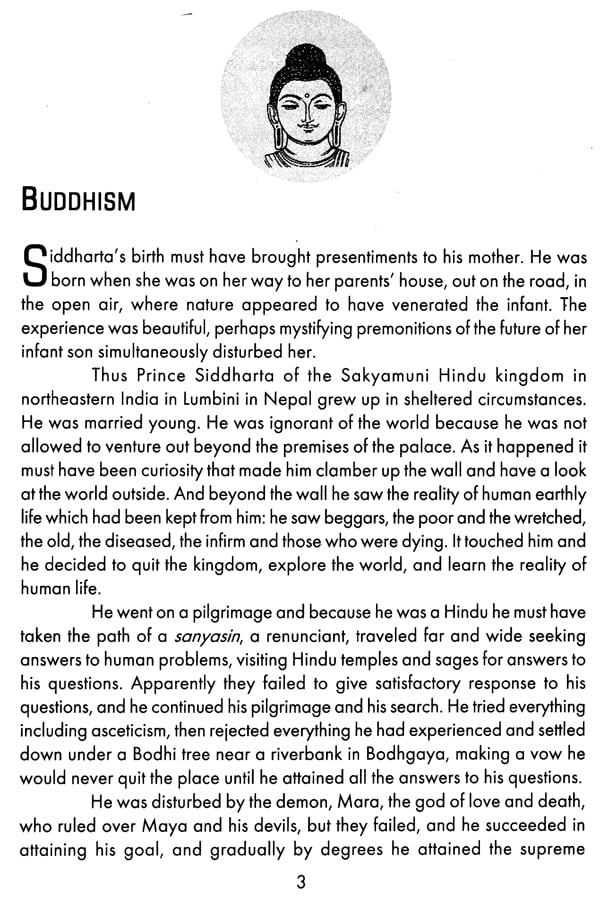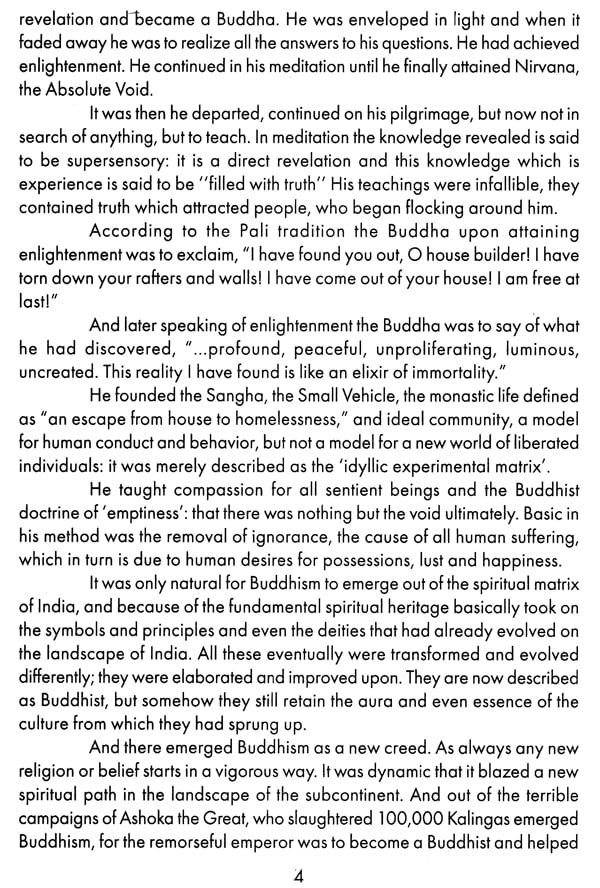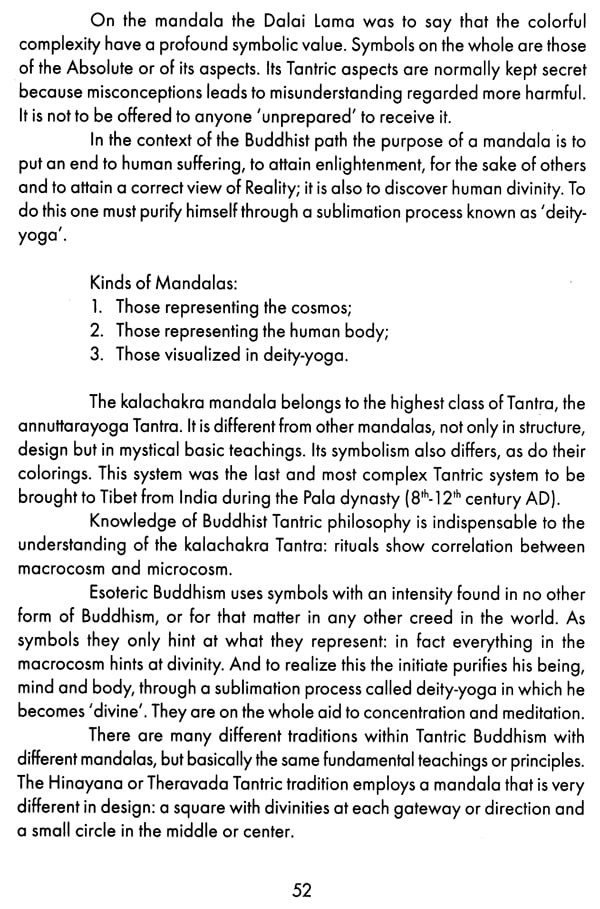
Sacred Mandala of Buddhism
Book Specification
| Item Code: | NAX775 |
| Author: | J.R. Santiago |
| Publisher: | Pilgrims Publishing, Varanasi |
| Language: | English |
| Edition: | 2011 |
| ISBN: | 9788177698213 |
| Pages: | 80 |
| Cover: | PAPERBACK |
| Other Details | 7.00 X 5.00 inch |
| Weight | 80 gm |
Book Description
It is only inevitable that old ways and things are replaced when they are no longer viable in the new social milieu or culture that has cropped up. Old principles, which were once effective, are no longer working. They have become redundant and obsolete. There is a search for new values, new ways of thinking and living. In the process there is a looking back, and suddenly the very old values, which had been ignored, surge up with an importance they never had before. The problem of the present times is no longer just economic but the emptiness or sterility felt in the human soul.
Buddhism as a creed has become very significant of late. It is perhaps the symbol of the Buddha, his aura of nirvna, conveying the possibility of attaining peace and a meaningful life amidst the chaoic and hectic way of life in our age. It is because of this interest in Buddhism that this introductory exegesis on the mandala worship has been written. It is for those who are still in quest of a spiritual path. It is not easy, but it might just be the right thing to those adrift and still groping and searching. The Buddhist mandala is regarded as an esoteric altar. Buddhism itself offers a comprehensive and intelligible creed, but for the beginner it is like plunging into esoteric worlds, out of one's mental reach, beyond one's intellectual grasp, with abstract concepts and ways of perceiving the world.
The Buddhist mandala, however, is really more astonishing and amazing for the scope it covers. Although efforts have been made to make it thorough, this short introductory work on the subject does not pretend to cover everything: this is simply impossible in a brief overview of the Buddhist mandala. An attempt, however, has been made to present a difficult subject in a lucid manner.
Buddhism sprang up from the spiritual matrix of India; because its goal is different, it emerged as a distinctly different creed. It is pragmatic, down-to-earth in its approach, with a goal that is not entirely different but similar in some respects to other creeds in the world. It did not concern itself with the question of the existence of God, which was central to other religion. It was only natural that it took up the sacred symbols, ritual artifacts, along of course with the Hindus deities and their attributes mainly because they were already traditional, and had grown deep roots in the psyche of the people. Included among those borrowed from Hinduism was the mandala form of worship and meditation.
Human suffering was central to the Buddha's concern. It could not totally be removed, but could only be alleviated. Human misery was physical and mental; and only the proper way of living could make people avoid diseases and pains; but it stems more from ignorance, a mental weakness, which has to be eradicated. The Buddha laid the Four Noble Truths. It follows the logic of syllogism with the proposition:
That human suffering was caused by worldly bondage; That this is linked to samsara, the cycle of birth and death, the principle of reincarnation, the desire to cling to life, to possession and happiness;.
That therefore suffering must be eliminated by the destruction of desire through the elimination of ignorance; That the elimination of ignorance, the basic cause of human misery, must be made through the Eightfold Path made up of the following: The right understanding, attitude, speech, action, conduct, effort, attention or mindfulness and meditation.
These make up the dynamics, the mechanism and process of attaining enlightenment, and therefore is the solution to human problems. It is a well structured system. This involves seeking sanctuary or refuge in the Three Jewels of Buddhism: the Buddha, the embodiment of Enlightenment; the Dharma or the Cosmic Law; and the Sangha, the community of monks. An aspirant on a spiritual quest must join the Sangha, become a monk to learn the Dharma for enlightenment and Buddhahood.
The Buddha established three vehicles in which an aspirant moves up until finally he takes up a postgraduate course.
Hinayana is known as the 'Small Vehicle'. It is also known as Theravada which holds that enlightenment can be achieved alone by self-discipline and by studying the Four Noble Truths and by following the Eightfold Path. The aim is to reach Nirvana, a state of peace, the final emancipation. This method could cover many lifetimes before Nirvana could be attained. The Theravada is followed mainly in Sri Lanka, Thailand and other countries in Asia.
Mahayana is known as the 'Large Vehicle'. Also known as the 'Middle Doctrine' or the 'Middle Path' it teaches moderation and temperance. This system requires the assistance of a teacher. It leads to Buddhahood, but its main precept is the enlightenment of everybody, or all sentient beings. The teachers defer Buddhahood or enlightenment until everybody has been enlightened. This could also therefore take several lifetimes. It is mainly followed in India, Nepal and Tibet.
Vairayana is known as the 'Diamond Vehicle'. It is also known as Tantrayana because its doctrines and principles are based on Tantra. Its main doctrine is that everyone is a potential Buddha and that enlightenment could be attained in one lifetime. It utilizes every available source of energy in the attainment of enlightenment. This system is considered the best and the highest, but it is also extremely difficult, and is on the whole followed by Buddhist in India, Nepal and Tibet.
This introductory book on the Budddhist mandala is in the main based on the Tibetan version of the Buddhist mandala, which appears now to represent Buddhism in the subcontinent. The Tibetan exodus when China invaded Tibet in the early 1960s resulted in the widespread introduction of Lamaism, the Tibetan version of Buddhism, its sacred symbols, including the worship of the mandala. It became the predominant form of Buddhism, mainly because of the popularity of the Dalai Lama and of the high lamas who wrote books on Tibetan Buddhism.
The Tibetan lamaist version of Buddhism indeed became popular and attractive. It offered not only a philosophy and a way of life, but also a science, which offered a way to enlightenment. This method employs the use of a mandala: the mandala form of worship entails a 'vast mass' of knowledge, of philosophy, science, and psychology. It requires a high lama proficient in the performance of the mandala ritual. The disciple here has to go through monkhood or attend classes before they could be initiated to learn the Dharma and attain Buddhahood.
The mandala worship is the final phase of initiation. This signifies that he has attained whatever knowledge could be transmitted to him, which should assist him to experience Nirvana. The mandala worship appears to be the last stage of monkhood or studentship, before he goes further in his progress on the spiritual path, alone and on his own. The definition and description of the Tibetan Buddhist mandala to a greater extent can be safely said to be almost comprehensive, and this is because one definition often does not cover the whole range of its meaning, and thus a definition could again be defined, and a definition of a definition is never therefore definitive, because in a spiritual sense it continues to expand until its essence or wisdom is completely absorbed.
The description of a mandala as a work of art is also to some extent in this brief introductory work almost comprehensive. This is also true of the utility or purpose of a mandala, but the processes followed in the Tibetan Buddhist ritual can only be given in a broad manner, as the relevant reference materials, perhaps, because of religious restrictions to keep the vital aspects secret from the uninitiated and merely curious. Even authors who had gone through the Tibetan mandala initiation and who had written about their experience were not able to put in detail the steps that were made in the stages and processes of the ritual.
Besides, of course, the texts on the spiritual experience were coached in phrases used only in religious rituals or liturgy, which are often very difficult to comprehend unless one had done some previous readings on eastern philosophy and religion including the Tibetan version of Buddhism and their practices and rituals. Spiritual concepts in particular are abstract and mystical, and even if there were dictionaries that define the vocabulary employed it would still require profound explanation by a high lama or teachers to understand them.
A background on Tantrism to some extent will help in understanding Vajrayana, the Diamond Vehicle, which is based mainly on Tantra. It will make one feel being on familiar ground, which over a period of time has been slightly altered, with principles remaining practically the same and with the same significance. For this reason it is also known as Tantrayana, but apparently inevitably some Tantric principles in Tibetan Buddhism had been so transformed that they are hardly recognizable as Tantra.
Some aspects of it, if not most of it, will remain intelligible. It is the highest and best method in reaching the spiritual goal. It is regarded as the fastest, but also the most difficult, because Vajrayana follows a mystical philosophy. The mandala form of worship is Tantric. And the origin of Tantra in folk cults is lost in the mist of primal time. It had apparently spread throughout the subcontinent including Nepal and Tibet, and even perhaps beyond; and when Buddhism emerged its basic constitution was made up of the Three Jewels: the Buddha, the Dharma and the Sangha, followed by the Four Noble Truths and the Eightfold Path.
In its evolution Hinayana appears to have been developed first, followed by Mahayana and finally by Vajrayana. These are the steps followed by Sakyamuni himself in attaining Buddhahood. It was through the Tantric form of meditation that he achieved enlightenment. Thus it forms the last stage on the spiritual path.
**Sample Pages**










